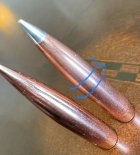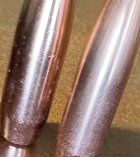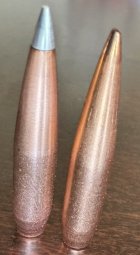Our only true “window” into firearms’ internal ballistics, which we normally have no means to directly observe, is that narrow cylinder gap in revolvers, where we can see such things as propellant preceding the projectile, if not obscured the speed and acceleration of the bullet in that window, possible bullet misalignment and yaw, duration of the charge’s continuing flame relative to muzzle exit, and derivatives that follow from being able to see the spectral intensity of the powder near the case mouth relative to muzzle.
We are in the dark with other firearms, drawing on inference from results. There’s three perceived possible benefits associated with seating depth tinkering: minimizing misalignment propensity, tuning the barrel’s exit timing, and managing peak pressure.
As to barrel timing, Keith’s video shows that there is not a lot of group size difference observable on target when variances in seating depth are fairly large. But there is some, most of the time. Because the worst depth is still sometimes the best group, I would find it very interesting to shoot just one depth, in three big sets at distance and see if there is approximately the same variation as when shooting three different depths. The test seems inconclusive on the issue of group size just as Keith acknowledges but it was plenty sizable to show that if there are differences, they are not large ones, but neither would they need to be.
There are still separate reasons of alignment and pressure, to tinker with seating depth. A bullet jammed into the lands requires higher pressure to be engraved than the same one with more velocity when first engaging the lands. There’s no doubt that higher peak pressure affects brass negatively, and it may also adversely affect soft bullets, and results in higher velocity. Seating deeper at the range after arrival, lowers the velocity of your load.
As to misalignment, this truly was a major consideration with older, secant ogive designs of a higher absolute BC. Bullet makers have tried to reduce seating depth sensitivity by “rounding off” the transition to the bearing surface everywhere like the tangent ogive design, before the chamber can possibly do that more to “one side” of the bullet’s transition, while retaining the triangular cone’s high BC. At least I think this was, mechanically speaking, the goal.
I think Berger hybrids have a more gentle transition to the body than the A-Tip, for example, this 245 EOL versus 250 A -Tip, though the differences lose a bit to the camera then again to resolution limits.
Then look at the last picture, the 190 A-Tip and the 183 SMK. I found that these bullets needed to be jumped considerably to shoot their best.
The difference in transition should be very noticeable, a visible belt line where the light reflects differently. These two 7’s went for broke in the design of the highest weight to BC in the 7mm match game, and they are sensitive to where we seat them, like the old Berger 180 VLD, which has a higher BC than the newer hybrid.
Appreciate Keith’s video for exploring the subject.
We are in the dark with other firearms, drawing on inference from results. There’s three perceived possible benefits associated with seating depth tinkering: minimizing misalignment propensity, tuning the barrel’s exit timing, and managing peak pressure.
As to barrel timing, Keith’s video shows that there is not a lot of group size difference observable on target when variances in seating depth are fairly large. But there is some, most of the time. Because the worst depth is still sometimes the best group, I would find it very interesting to shoot just one depth, in three big sets at distance and see if there is approximately the same variation as when shooting three different depths. The test seems inconclusive on the issue of group size just as Keith acknowledges but it was plenty sizable to show that if there are differences, they are not large ones, but neither would they need to be.
There are still separate reasons of alignment and pressure, to tinker with seating depth. A bullet jammed into the lands requires higher pressure to be engraved than the same one with more velocity when first engaging the lands. There’s no doubt that higher peak pressure affects brass negatively, and it may also adversely affect soft bullets, and results in higher velocity. Seating deeper at the range after arrival, lowers the velocity of your load.
As to misalignment, this truly was a major consideration with older, secant ogive designs of a higher absolute BC. Bullet makers have tried to reduce seating depth sensitivity by “rounding off” the transition to the bearing surface everywhere like the tangent ogive design, before the chamber can possibly do that more to “one side” of the bullet’s transition, while retaining the triangular cone’s high BC. At least I think this was, mechanically speaking, the goal.
I think Berger hybrids have a more gentle transition to the body than the A-Tip, for example, this 245 EOL versus 250 A -Tip, though the differences lose a bit to the camera then again to resolution limits.
Then look at the last picture, the 190 A-Tip and the 183 SMK. I found that these bullets needed to be jumped considerably to shoot their best.
The difference in transition should be very noticeable, a visible belt line where the light reflects differently. These two 7’s went for broke in the design of the highest weight to BC in the 7mm match game, and they are sensitive to where we seat them, like the old Berger 180 VLD, which has a higher BC than the newer hybrid.
Appreciate Keith’s video for exploring the subject.
Attachments
Last edited:














